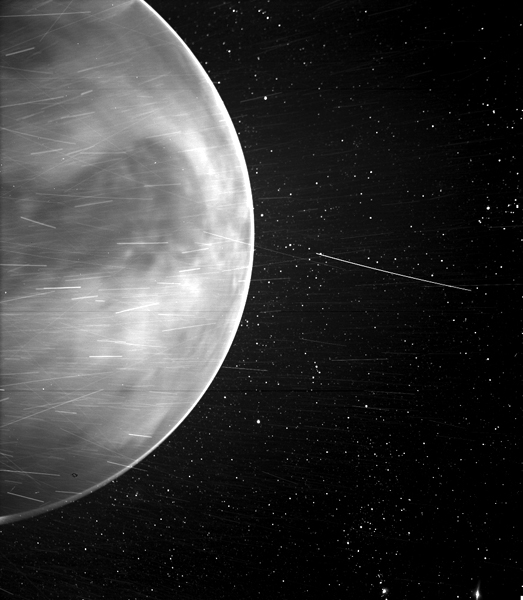
NASA / Johns Hopkins APL / Steve Gribben
NASA’s Sun-Bound Parker Solar Probe Swings Through Final Venus Flyby (News Release)
Gravity-Assist Maneuver Sets Up Record Close Approach to Our Star
On November 6, NASA’s Parker Solar Probe completed its seventh and final Venus gravity-assist maneuver, passing within 240 miles (about 387 kilometers) of Venus’ surface. The flyby adjusted Parker’s trajectory into the final orbital configuration of its primary mission, bringing the spacecraft to within an unprecedented 3.8 million miles of the solar surface on December 24, 2024.
Monitoring the maneuver through NASA’s Deep Space Network, the mission operations team at the Johns Hopkins Applied Physics Laboratory (APL) in Laurel, Maryland — where Parker Solar Probe was designed and built — confirmed that Parker was operating normally as it reached closest approach to Venus at 1:43 p.m. EST, flew precisely through its planned “aim point” and then began its swing in toward the Sun.
“We’re reaching the crescendo of Parker’s incredible voyage through the inner Solar System,” said Yanping Guo, Parker Solar Probe mission design and navigation manager in APL’s Space Exploration Sector. “More than six years after launch, this incredible spacecraft continues to exceed all expectations, and we can’t wait to see what Parker uncovers on its closest approaches to the Sun.”
Parker is now on course to reach the final objective of a historic mission conceived over 65 years ago: flying within 3.8 million miles (around 6.1 million kilometers) of the surface of the Sun. No human-made object has ever passed this close to a star, so Parker will be returning data from uncharted territory. As Parker passes through the Sun’s atmosphere, it will cut through plumes of plasma still connected to the Sun.
It will be close enough to pass inside a solar eruption, like a surfer diving under a crashing ocean wave.
“This is the vision generations of scientists have dreamed of realizing since 1958,” said Nour Rawafi, the Parker Solar Probe project scientist at APL.
During its Christmas Eve closest approach, or perihelion, mission control will be out of contact with the spacecraft, although Parker will transmit beacon tones on December 21 and December 27 to confirm its health. The spacecraft will remain in this orbit for the remainder of its primary mission, completing two more perihelia at about the same distance and speed — a record 430,000 miles (692,018 kilometers) per hour — in March and June 2025. After that, the team will decide whether to keep the spacecraft in that orbit or reposition it.
New Science
Early mission plans didn’t include any planetary science at Venus. But that changed shortly after launch in 2018, and Parker’s better-than-expected performance allowed the team to adjust its observational programs.
One reason why Parker’s Venus flybys have become boons for new science is a chance discovery from the spacecraft’s Wide-Field Imager for Parker Solar Probe, called WISPR. The instrument peers out from Parker and away from the Sun to see fine details in the solar wind. But on July 11, 2020, during Parker’s third Venus flyby, scientists turned WISPR toward Venus in hopes of tracking changes in the planet’s thick cloud cover. The images revealed a surprise: WISPR, which captures visible and near infrared light, seemed to see the Venusian surface.
“The WISPR cameras can see through the clouds to the surface of Venus, which glows in the near-infrared because it’s so hot,” said APL planetary scientist Noam Izenberg.
Venus, sizzling at approximately 869° Fahrenheit (about 465° Celsius), was radiating through the clouds.
The WISPR images from the 2020 flyby, as well as the next flyby in 2021, revealed Venus’ surface in a new light. But they also raised puzzling questions, and scientists devised the final flyby to help answer them.
The Venus images correlate well with data from the Magellan spacecraft, showing dark and light patterns that line up with surface regions that Magellan captured when it mapped Venus’ surface using radar from 1990 to 1994. Yet some parts of the WISPR images appear brighter than expected, hinting at extra information captured by WISPR.
Is WISPR picking up on chemical differences on the surface, where the ground is made of different material? Perhaps it’s seeing variations in age, where more recent lava flows added a fresh coat to the Venusian surface.
“Because it flies over a number of similar and different landforms compared to the previous Venus flybys, the November 6 flyby will give us more context to evaluate whether WISPR can help us distinguish physical or even chemical properties of Venus’ surface,” Izenberg said.
Rawafi said that imaging was just part of the flyby’s science agenda. Shaped under Rawafi’s direction for more than a year, the comprehensive plan also included a look at the different components of Venus’ exosphere and their interactions with the Sun. The Parker team expects to begin receiving the first bits of that data later this month, he added, with plans to present some of its findings at the American Geophysical Union’s Fall Meeting the week of December 9 to 13.
“The science data we’ve gathered over these seven Venus flybys is a real tribute to Parker’s versatility, and have enabled new avenues for research on Venus,” Rawafi said. “The seventh Venus flyby, however, was especially unique, in that spacecraft flew through the planet’s nightside and plunged deep into its atmosphere. We’re anticipating some exciting surprises when the data comes down.”
Source: Johns Hopkins Applied Physics Laboratory
****

NASA / Johns Hopkins APL / Naval Research Laboratory / Guillermo Stenborg and Brendan Gallagher

No comments:
Post a Comment